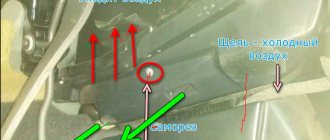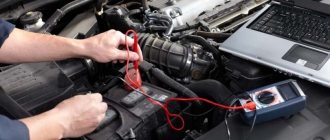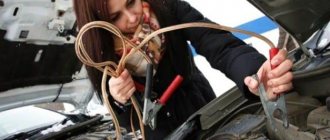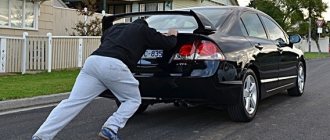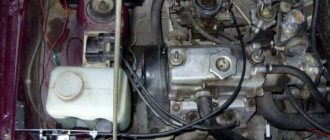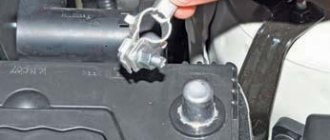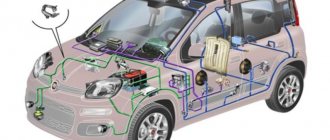Problems with the generator and its complete malfunction do not necessarily mean abandoning the car. The only question is the distance that the battery alone can handle. How long you can drive on a battery without it depends on several factors. These include various conditions and additional consumers.
Electricity consumption of devices
The battery capacity is designed to work independently. The fact is that the generator begins to compensate for energy only a few seconds after the car starts. The engine starts and the on-board equipment is powered for the first time using one battery.
The duration of operation without recharging depends on both external influences and the power source itself. The first include weather conditions, the number of electrical appliances and the current they require. The energy consumed by the equipment is affected by the state of charge of the battery. When the latter approaches zero, the indicators increase sharply. The same car with the same devices turned on will travel different distances if in the first case it has a new battery, and in the second case it has an old battery. Taking into account the normal state and conditions, you can focus on the following numbers.
| Consumer | Required current, A |
| Horn | from 1.5 to 3 |
| Fan | from 3 to 6 |
| Cruise control, headlight range control | from 0.5 to 1 |
| Dimensions | from 1 to 2 |
| High and low beam headlights | from 7 to 15 |
| Rear fog lamp | from 5 to 15 |
| Heated seats | from 7 to 14 |
| Heated rear or front glass | from 4.5 to 9 |
| Stove | from 14 to 30 |
| Radio tape recorder | from 0.5 to 2 |
| Wipers | From 2 to 5 |
| Windows, electric sunroof | from 5.5 to 11 |
How long will the car run on the battery without charging?
To determine how far and how long a vehicle will travel on a battery without a generator, you need to find out its parameters and design features. The injection type discharges faster than the carburetor type. But the main indicator is capacity, which shows the potentially permissible load. It corresponds to the engine displacement. Its value is indicated on the power supply label
On average, the capacity of passenger vehicles is 55-75 Ah; for trucks it is larger. The number written on the label corresponds to +25°C. It determines the current at which the battery will be discharged in 20 hours. The lower limit is considered to be a voltage of 11 V. When calculating how much you can drive on one battery, you need to take into account the inaccuracy of this parameter. The figure declared by the manufacturer is a nominal value, the real value ranges from 80 to 110% of it. Example: capacity 55 A*h, the voltage will drop completely after 20 hours at a current of 55/20 = 2.75 A. When calculating the distance, it is necessary to take into account the electricity consumption of the battery. There are constant loads that cannot be avoided. Turning on the headlights, fan, and heated glass is not always necessary. Moreover, the higher the engine speed, the greater these indicators will be. To solve the problem, it is necessary to add up the expenses of all consumers.
| Regular consumer | Required current, A |
| Fuel pump | from 2.5 to 5 |
| Injector | from 2.5 to 5 |
| Ignition | from 1 to 2 |
| Dashboard | from 0.5 to 1 |
How to calculate how many kilometers a car will travel without a generator?
For example, let’s find out how long a car with an injection engine with a capacity of 60 Ah will travel with the headlights and fan on in the warm season. The latter consume together about 15 A, four constant consumers about 8 A. This number was obtained due to the injection system, which draws about 4 A, while the carburetor system draws about 2.5 A. As a result, the current is 23 A. The operating time is calculated as follows: 60/23=2.6 hours. At an average speed of 90 km/h, the car will cover 234 km on its battery without charging the generator. Attention! This result is theoretical, since if the voltage drops by 75%, the rate of power loss will increase sharply. A number reduced by a quarter will be closer to reality. However, it is typical for a charged battery in good condition. Also, the initial data is based on indicators at above-zero temperatures; in winter they will be lower. As a result, in the above example, 175 km can be covered under the best conditions.
How long will the car travel?
To understand how long a car will travel on a battery without a generator, you need to familiarize yourself with its design features and parameters. In particular, it is worth paying attention to the capacity, which determines the maximum permissible load. For passenger cars it averages 55-75 A/h, and for trucks it is an order of magnitude higher. At the same time, the figure indicated on the label is valid at +25°C and from it you can determine the current level at which the battery will discharge after 20 hours of operation.
When making calculations, you should also remember about parameter errors. As a rule, the values declared by the manufacturer are nominal, while the real ones are 80-110%. For example, with a declared capacity of 55 A/h, the battery will be discharged after 20 hours at a current of 2.75 A (55/20). And, in order to calculate the exact distance, it will be necessary to take into account all the electricity costs that cannot be avoided when operating the car (you should add up the consumption of all appliances and devices that cannot be avoided). In particular, it is difficult to imagine a vehicle that can function without a fuel pump or injector, which consumes up to 5 A of alternating current, the ignition will require another 1-2 A, and the instrument panel will require up to 1 A.
What to do if you need to drive without a generator?
If necessary, a car can travel a certain distance on one battery. But before you set off, you need to prepare and evaluate the road ahead. You cannot expect to cover the maximum distance, because force majeure is always possible, so the first task is to find out the location of the nearest service or populated area. Various cases: being left without charging a generator at your place of stay, even temporary, or in the middle of the road. The first situation is obviously easier than the second. If possible, you need to find out how far a vehicle can travel on a battery without a generator. Use calculations adjusted for aggravating factors: frost, incomplete charge. The latter is defined in two ways. Measure the voltage with a voltmeter. To do this, the battery is disconnected from the on-board network. A value of 12.2 V and below indicates that the charge level is less than half. For the type of battery being serviced, the electrolyte density is measured. It should be in the range from 1.26 to 1.29 g/cm3. The lower the indicator, the greater the degree of discharge.
If the result is low, then in order to cover an additional 60-70 kilometers it is better to take a spare battery on the road or recharge the power source. To do this, you will need a special device, but it requires connection to an outlet. This method is only suitable for those who encounter a problem not on the road. But there are also portable devices, however, the degree of their effect is small. Moreover, they are not always at hand. The process is demonstrated in a video: https://www.youtube.com/watch?v=kNJh3ZHwrSU
How many kilometers can a car travel without a generator?
To calculate the distance that a car can travel, you need to know its design and basic parameters. The main indicator from which to base the calculation is capacity; it indicates the permissible load and corresponds to the displacement of the engine. This number is always indicated on the battery label.
The capacity of a passenger car is from 55-75 Ah, while that of a truck is higher. The sign on the label is +25°C. Using this number, you can determine the current at which the battery will be completely discharged within 20 hours.
The number indicated by the manufacturer is nominal, it ranges from 80 to 110% of it. Let's look at an example. Capacity 55 Ah, battery will be discharged after 20 hours. 55/20=2.75 Ampere. When making calculations, it is necessary to take into account the electricity consumption of the battery. There is a constant load that cannot be avoided. Whereas it is quite possible to turn off the headlights, heated seats, and the tape recorder. It is also necessary to take into account the engine speed. To obtain the correct result, it is necessary to sum up the electricity consumption of all consumers.
How to calculate battery life
As an example, we take a car with an injection engine and a capacity of 60 A*h, the headlights are on, the fan is on, and the season is summer. The total consumption is approximately 15 Amps. Constant consumption – 8 Amperes. The figures appeared taking into account the injection system, which is 4 Amperes; if the carburetor system is taken into account, the figure will drop to 2.5 Amps. Total current - 23 Amperes. Operating time is calculated using the following formula: 60/23=2.6 hours.
At a speed of 90 km/h, the car can travel 234 km on one battery. Attention! This result is purely theoretical. It must be taken into account that electrical energy losses will increase sharply while driving. These calculations are close for a battery in ideal condition, which is fully charged. It should be clear that in the winter season the figures will be lower.
What to do when the question arises: “Should I drive on one battery or not?”
In an emergency, you can count on the car to travel a short distance on battery power alone. But it’s better not to take risks and, if possible, evaluate the road. Don't think you can cover the maximum distance without problems, so find out where the nearest service station is. It’s better to play it safe and think about how you will get out of the situation if you are left alone on an empty road away from people.
When starting calculations, take into account the incomplete charge of the battery and frost. You can measure the battery voltage using a voltmeter. Disconnect the battery. Figures of 12.2 V or less indicate a charge of less than 50%. Electrolyte density is from 1.26 – 1.29 g/cm3. Here, a lower indicator indicates a greater degree of discharge.
To be more confident, you can take a spare battery with you or recharge the one you have. This option, of course, is not suitable for everyone.
What to do if the generator stops working on the road?
There are emergencies when it is not possible to prepare. Some rules will allow you to travel the maximum distance on one battery to get to the service. To achieve this, all energy costs and factors that increase them are reduced to a minimum. In practice, you need to do the following:
- do not use electrical equipment;
- instead of high and low beam, turn on the side lights or emergency lights;
- accelerate slowly to reduce engine speed;
- for this purpose, go down the mountain in coasting gear;
- try not to turn off the car so as not to waste energy starting it.
When it is not possible to avoid the latter, then there is a risk of not being able to restart the car on a battery without a generator. It is unlikely that you will have a spare battery for your car on the road. A portable charger, if available, will come in handy. There is another option - to “light” from a car with a normal battery. But here you need a cable and a donor vehicle. The second should be comparable in capacity.
HOW CAN.
DRIVE WITH BATTERY WITHOUT RECHARGING
TEXT / VLADIMIR ARBUZOV
When the battery and generator live in harmony, we don’t notice it. It starts up in the morning, the headlights shine, warmth blows from the “stove” - and thank God! And once every few years, the battery can be replaced with a new one, without even delving into the reasons for its failure.
Problems begin when the battery suddenly loses power. The magazine has talked more than once about how and where to look for it. But if trouble strikes you on the road, you first need to get home. How long will the battery last if there is no recharge?
This is what we set out to find out. First, let's designate the initial conditions. It’s one thing when the battery is fresh and fully charged, it’s a long summer day outside and you don’t need to turn on the headlights. And it’s completely different - winter, night, the battery is barely alive and, without the help of a generator, good for nothing. However, driving with this is like driving with a leaky spare tire - sooner or later your carelessness will come back to bite you.
Let's consider the most typical life situations.
First, the battery is fresh and fully charged. Precisely completely, from a stationary charger - the one that works on the car is always a little undercharged. The voltage regulator maintains a maximum of 14.2 V in the circuit, while a full charge requires all 17 V. This can happen, for example, in the country, when it is impossible to repair the generator, but there is electricity and a charger.
The second option is that the charger disappeared on the road. The charge level of the battery is the one remaining at the moment. It’s night, raining, cold, so, in addition to the engine, the headlights (at least one left), windshield wipers, and heater need electricity. What to expect in such circumstances?
For the experiment, we bought two new Tyumen batteries, checked the electrolyte density (it turned out to be 1.25 g/cm3, which allowed us to consider the batteries conditionally fresh - there was no manufacturing date on them) and conducted control and training cycles for each. The density stabilized at 1.28 g/cm3, and the charging end voltage was 16.3 V.
So, two “nines” - injection and carburetor - are ready to go on the route. We install new batteries on them, turn off the generators, measure current consumption - and off we go.
The injection draws 4.5 amperes from the battery, the voltage on board is 12.3 V. The carburetor is content with less - 2.4 A and, accordingly, the voltage in its network is 12.7 V. The weather is favorable - sunny morning, warm; We do not turn on the headlights, heater and windshield wiper blades - there is no need. "Stops" and "turns" work as needed.
Theoretically, even a power-hungry injection “nine” should get from Moscow to St. Petersburg on one battery charge, and even more so with a carburetor - its fuel pump does not consume a single gram of electricity.
There are 473 kilometers behind. The mains voltage is 11.6 and 12.5 V. There is still gunpowder in the flasks! But after an hour-long break, it did not grow at all - the low discharge current drains the battery thoroughly, leaving it no chance to restore its strength on its own. However, we did not count on this, but checked it solely for the purity of the experiment.
It was getting dark, the “dimensions” were turned on, the voltage immediately dropped to 11.2 and 11.7 V. The lighting in the instrument cluster noticeably dimmed, but you can drive. We are pulling with all our strength, the arrows of the control voltmeters are inexorably creeping down.
The first, of course, was the injection one - 7.5 volts is the limit for it. The mileage was 637 km, travel time 7 hours 15 minutes. Well, not bad! Within this radius, as a rule, you can find the necessary help, unless, of course, you travel across the tundra.
Meanwhile, the carburetor “nine” does not even think about “dying”. Its peppy 11.5 V promises to travel the same distance, but who drives at night without light! To save money, we turn on the low beam on the left headlight and drive on. “Injection”, having received a spare battery, is in the lead, illuminating the road, and we, “one-eyed”, with a dim yellow headlight, are firmly sitting “on the tail”. But 716 km and 8 hours of driving also finished off the second car. The mains voltage is 5.4 V.
Note that the injection “nine” stalls immediately, without warning, while the carburetor engine missed flashes for the last ten minutes, twitched and, only after finally draining the battery, stalled.
We will assume that with economical consumption of electricity, the battery capacity is quite enough to get home. But these are still gentle conditions, but what is the survivability of the machine under normal conditions?
We charge the batteries again, but on the cars themselves from standard generators, and in the evening of the next day we set off on the return journey. By the way, we note that in the first minutes the charging current was 36 A for the injection “nine”, and 49 A for the carburetor. Such a significant difference is explained by the higher degree of discharge and, as a consequence, the lower resistance of the second battery.
Broken alternator belt - how far can we go without it? ZR experiment
While on the road, the accessory drive belt may break. I will prove that in such a situation you can get to the house or the place of repair without resorting to outside help.
LADA > Largus
On a weekday winter day, in the center of traffic jams in Moscow, we decided to check the “survivability” of a car with a broken auxiliary drive belt. Oddly enough, in the middle of a metropolis in such a situation you can get pretty miserable. The traffic is so dense that there is no hope for either towing or a quick arrival of a tow truck. Most likely, you will be fined for stopping in the wrong place. The diametrically opposite option is when there is “steppe and steppe all around” and you need to get to people to get help.
In our car - Lada Largus - if the belt breaks, the generator, power steering and air conditioning compressor will stop working. Air conditioning is not very important in winter. The absence of a hydraulic booster will remind us of power steering techniques, and a non-rotating generator will not recharge the battery, limiting our experiment in time.
Before starting the experiment, we check how the steering wheel rotates on a working car.
Now we dismantle the auxiliary drive belt. To do this, I had to remove the right front wheel and the plastic mudguard.
We start the engine and immediately see a warning light with a battery symbol, which indicates a lack of charge. We note the start time of the experiment. We quickly determine the force required to turn the front wheels.
On cars with power steering, in the absence of fluid supply from the pump, the force is quite large. The amplifier not only does not help, but even interferes. This is due to the fact that the fluid in the steering rack has to be pressed from one volume to another, using the only source of energy - muscle power! In this sense, a failed electric power steering puts less burden on the driver.
It's time to go for field tests around the city.
In this mode, electrical energy consumers should be turned on as little as possible. After all, on a modern car, the fuel pump, engine management system and ignition system are constantly working. The brake lights come on periodically and the direction indicators turn on. All this drains the battery.
Immediately after this, the current consumed by all turned on electrical equipment of the car was determined. It is in the range of 21–22 A.
The harsh testing hours dragged on. Traffic in traffic jams is jerky, in short bursts. Average speed is 12 km/h. And turning the steering wheel in corners is not easy.
Well, for now let’s speculate on the topic of how much time it will take us to test. There is a concept called “battery reserve capacity”. This value just characterizes how long the battery will last at a current consumption of 25 A. So, for batteries with a capacity of about 60 A∙h, this time is approximately 100–120 minutes. But this is for a fully charged battery in laboratory conditions. Our experiment involves a battery that has served for 1 year and is charged by the car’s standard generator during daily relatively short trips of 10–12 km (twice a day) in traffic jams in Moscow.
It will be useful: Which thermostat to put on the viburnum
A voltmeter connected to the car's on-board network shows a gradual decrease in voltage, but the car is still moving completely normally. It was only when the voltage dropped below 7.8 V that interesting things began to happen.
The experiment ended after two hours of continuous movement. During this time the car traveled 24 km. That is, with a decent battery, even from the center of a traffic jam city you can get to the outskirts. And on an unloaded highway with good average speeds you can cover 100–150 km. After all, a car's electricity consumption almost does not increase with increasing speed. Our experiment showed that it is possible to get to the repair site without an accessory drive belt.
It should be noted that you can only get there in this way on cars with a timing belt drive. However, there are exceptions among them: sometimes there are engines in which the timing belt is driven by a belt, but the pump is rotated by a belt of auxiliary units. In this case, and also when the camshafts are rotated by a chain, the trick we described will not work. The pump will not pump coolant. With such a malfunction, in a modern car you can only drive it to the side of the road. Prolonged driving will inevitably lead to overheating of the engine.
Tell us in the comments, have you ever had to get to your home or repair site with a broken belt?
How long will the battery last?
It is difficult to determine exactly which route you can travel with a faulty generator. There are too many factors influencing this. You can get the most mileage when driving evenly in a straight line, at above-zero temperatures, with an unloaded car and a new battery. But we all know that “in reality everything is not as it really is”© and there are no ideal conditions.
It is enough to simply determine the time, or in other words: how long will the battery last? It's not that hard to find out.
For most batteries, not only the nominal capacity is written on the case, but also the reserve capacity - RC (Reserve Capacity) , measured in minutes. In other words, this is the amount of time during which the battery will supply the car with enough electricity to operate if the generator is faulty.
Reserve capacity is the amount of time required to discharge the battery with a current of 25 amperes to a voltage of 10.5 volts and a temperature of 25 C°.
And if suddenly, along the way, the generator breaks down, then by opening the hood and reading the RC indicator on the label, we will at least approximately know how much time we have left.
Causes
Let's look at the reasons why a strap on a Solaris, Priora or other vehicle may burst and break.
Pulleys and Alignment
Incorrect installation of the pulley is one of the main reasons why the belt may break. If there is no alignment, this contributes to incorrect rotation of the elements. The pulleys touch other components and mechanisms, causing the belt to wear out faster. The shaft on the power steering pump unit is installed backwards - the alignment is broken. Experts advise periodically diagnosing the condition of the crank pulley for runout. The appearance of uncharacteristic sounds is often caused by a violation of alignment. A dial indicator is used for diagnostics.
The presence of runout should be checked directly on the unit, on its tension roller. Proper testing will reveal the presence of misalignment. Open the hood and look at the strap. If the product is tensioned evenly, this indicates that the pulleys are installed in the same plane. In the case of V-straps, slight wear is allowed, but not more than 1 mm per 10 cm . Please note that misalignment is caused by incorrect installation of the components themselves, and not the pulleys. For example, if a non-original pump is installed on Logan or Kalina, the alignment is disrupted. Diagnostics will show a large difference from the hub directly to the base.
Vehicles may use prefabricated pulleys made of two parts and joined by spot welding. When the strap is tightened, the weld often cannot withstand the high load and falls off. Due to the tension, parts of the pulley move apart, as a result of which the product falls into the resulting gap and breaks. If a non-original pulley with a smaller diameter is used, the load on the generator device will be higher. This will cause the strap to slip, which ultimately contributes to accelerated wear on the sidewalls. Some car owners, to save money, do not change such pulleys, but place washers and other materials under them to compensate for the sizes. This way you can achieve optimal alignment, but it is better to simply change the shaft.
How a generator set with a jammed pulley works, watch the video (author - STO Kovsh channel).
A problem in the operation of the pulley can arise when burrs form on the plane. When its surface wears out, small, barely noticeable scuffs appear, causing damage to the rubber material of the strap structure. Hangnails are a serious problem. Because of them, the belt can wear out in less than one week.
As for the pulley itself, sometimes the reason for the break lies in its high rigidity. On some older Russian-made cars, new straps are not designed for hard metal. Such machines use pulleys made of Soviet steel, and the design of the device itself is non-separable and stamped. It is better to replace such a pulley, since belts for hard metal shafts are difficult to find. It is advisable to use a light alloy product.
If there are burrs on the pulley, the surface of the device should be filed and sanded. This will increase the service life of the belt. If the vehicle is actively used, it will last at least one year. Due to incorrect alignment, the strap twists, as a result of which the battery cannot hold a charge for a long time. This is due to the inability of the generator device to produce the required voltage level.
What to do if it breaks?
When faced with such a malfunction on the road, you need to make a decision quickly and correctly. If it’s not far from home or the place of repair, then you can continue driving directly at the expense of the battery.
Important! It is possible to drive a car without a generator, although it is not advisable.
The greatest discharge of the battery occurs when starting the engine, so if the generator is faulty, it is recommended not to turn off the engine unnecessarily, because this will significantly reduce the battery discharge time. When it is still necessary to turn off the engine, try to stop on a hill or slope and start the engine “from the pusher”.
Without a generator, the car will start, but it is unknown whether the car will start after a long trip on the battery alone.
Sometimes you can immediately assess the malfunction and the possibility of repair here and now.
What happens if you put a battery of a different capacity in the car?
Many car enthusiasts have wondered whether it is possible to use a battery in a car with a capacity that differs from that recommended by the manufacturer. But what will happen if you still install such a battery? There is an opinion that if you install a battery with a smaller capacity, it may overheat and boil during operation. And if you use a larger one, the battery will not be fully charged all the time. And this will lead to rapid breakdown.
What depends on the battery capacity
Battery capacity is its capacity, that is, how much charge the battery can hold itself. This parameter is measured in ampere-hour. In simple terms, the capacity shows how much current must be applied to discharge the battery in one hour. In a car, the battery is needed to power the starter, which starts the engine. Energy is also used when operating electrical appliances.
Typically, the manufacturer recommends one or another battery capacity value for the normal functioning of the car. On batteries we see this parameter 45, 60.75 Am*h. This is the battery capacity.
The voltage of car batteries is approximately constant - 12.7 V. But the capacity depends on the functionality of the car and engine size. If the car is equipped with a large number of electronics and has a 2.0-3.5 liter engine, then the battery should have a capacity of 60 - 75 Am*h. And for a small car with an engine capacity of 1.2 - 1.5 liters, a battery of 45 Am*h is enough.
Every car has a power supply. It includes: a battery from which energy is supplied to the generator, a starter, and an on-board network.
The on-board network uses very little energy. Unless, of course, there is additional energy-intensive equipment. The starter only works when the engine starts. On average, it needs 1-2 Amps of energy. During the cold season, this figure increases. After starting the engine, the generator must compensate for the loss of battery current.
The generator also has characteristics. This is power. It can be 40, 70, 80 A and so on. This characteristic indicates the maximum current that the generator can produce per hour. But the current required to recharge the battery is several times less.
What happens if you install a battery of a different capacity?
So what happens if you put a larger capacity battery in your car? The battery will simply take longer to charge. But, consequently, the current will be enough for her for a longer time, which is especially important during the cold season. Since energy is needed not only to turn the pistons, but also to thicken the engine oil.
It is believed that if you install a battery with a smaller capacity than stated by the manufacturer, then during charging the battery may overheat and boil. But that's not true. All modern cars are computerized. And as soon as the charge reaches the required numbers, power from the generator will stop supplying the battery.
How to choose a battery
When choosing a battery you need to consider:
-Generator power.
-Car electrical equipment. Since the amount of energy consumed by the on-board network depends on the number of electronics.
- Dimensions of the machine. The larger the battery capacity, the larger its dimensions. And a battery with a capacity of 75 Am*h simply won’t fit in a small car.
-Climatic conditions. In cold weather, more energy is needed to start the engine, so it is advisable to take a more capacious battery.
-The distances you will travel. On short trips, a high-capacity battery will not be fully charged. So there is no point in buying a “big” battery.
If you decide to install a battery of a different capacity, then nothing bad will happen. The main thing is that the battery fits in the regular place of the car.
Why might a generator fail?
A car's generator is a fairly reliable unit, but it can also break down while on the road. In this case, the only source of electricity will be the car battery, and its supply will be exhausted.
The most common breakdowns of a car generator include:
- Break or short circuit of the turns of the stator winding, or field winding (located on the rotor). A very serious breakdown, which cannot be corrected on the way.
- Malfunction of the brush assembly, that is, damage to the brushes or their freezing. With such a malfunction, the generator can continue to generate energy, but it will not be enough for full autonomous operation.
- Damage to the rectifier unit. Usually it consists of a burnt-out diode bridge; such a breakdown is not repaired, but the entire rectification unit is replaced.
- Failure of the rotor shaft bearings. The bearing may not only wear out and begin to whistle and grind, which in itself is unpleasant (while the energy supply will continue), but it may simply jam the generator rotor - and this requires mandatory removal of the generator belt, right at the site of the breakdown. Otherwise, the belt itself will fray and burst. The bearing needs to be replaced, the generator rotor needs to be checked.
- Broken wire at output terminal. Although the breakdown can be solved, it is quite dangerous, because the generator continues to supply energy to the broken wire. A piece of wire will simply cause a short circuit and fire.
Most breakdowns do not completely disable the generator, and it will still continue to provide the car with at least part of the required voltage. Or these problems can be eliminated if detected in a timely manner. But some malfunctions will not allow the generator to work at all and require complex repairs or even replacement of individual components.
Is it possible to drive without a belt?
Separately, it is worth noting a broken alternator belt as one of the most common malfunctions, and also because it can be corrected yourself right on the road.
Yes, you can drive without an alternator belt, but you can also replace it.
If the alternator belt breaks, it can be replaced with improvised means, but this should only be done in cases where a thorough repair is impossible, but it is necessary to continue a long journey.
How long can you drive without an alternator belt?
Time of day (headlights consume energy), presence of rain (windshield wipers consume energy), presence of heat (fan consumes energy).
In general, in the summer, during the day in sunny weather, I once happened to drive about 100 km on Niva. The battery was new, domestic.
—————— Hands on the shutter, head in anguish, but my soul seems to have already taken off. Why do we write in blood in the sand? Our letters are not needed by nature. (With)
Without headlights, heater, etc. You can drive for about five hours with a petrol car.
| Kostyanich |
| Maxim V | 1) What kind of engine: If the internal combustion engine is gasoline, then. a) Injector or crab. b) Fuel: gas or gasoline c) If diesel, then what kind of power supply system - mechanical fuel injection pump or “common” or pump injector. 2) Year of manufacture of the car. 3) Battery capacity. 4) Battery condition. 5) Traffic conditions. 6) Time of day. 7) Time of year. If the internal combustion engine is gasoline, then: a) Injector or crab. b) Fuel: gas or gasoline Here is an approximate list of questions to which you need to know the answer and only after that you can approximately say that you can drive from 5 km to 300 km on a battery. a) Injector or crab. b) Fuel: gas or gasoline c) If diesel, then what kind of power supply system - mechanical fuel injection pump or “common” or pump injector. 2) Year of manufacture of the car. 3) Battery capacity. 4) Battery condition. 5) Traffic conditions. 6) Time of day. 7) Time of year. If the internal combustion engine is gasoline, then: a) Injector or crab. b) Fuel: gas or gasoline Here is an approximate list of questions to which you need to know the answer and only after that you can approximately say that you can drive from 5 km to 300 km on a battery. |
| Steelyard | I drove about 150 on a carb chisel during the day without headlights, and I can’t say that the battery was very low from this. |
| Dimaka72 | I drove 130. (back there) On the way back we had to start it with a pusher... fortunately it’s light |
There was an incident several years ago. Then I had a VAZ 4. On December 31st, in the evening, my wife and I drove 300 km from Moscow to the Tver region. to meet friends to meet New Year. About 30-35 km from Tver - the charger died. Winter, New Year's Eve is just around the corner, it's dark, no one is working anymore, everyone is starting to celebrate. I managed to find a working auto shop in Tver, and bought a PP and a new battery there. And I moved on. The only thing I did was remove the connector from one headlight. Still, 55 watts of consumption is minus, but you can drive with just one headlight. I drove naturally until the original battery was completely dead. It was not new, it was already 2 years old by that time. When I looked at the map later, I managed to drive about 120 km. Then I installed the second account and calmly drove to my friend’s place.
| Old Boy |
| aust |
Those. Is it possible to drive (with a deceased person, a broken belt, for example) without a generator for about 100 km without problems? |
quote: about 100 km without problems?
quote: a broken belt, for example) without a generator, about 100 km without problems?
Or maybe it would be easier to change the belt?
| Maxim V |
| aust |
where can you get it in the village? They weren't cheating, after all. And not everyone carries a set of sockets/keys with them. By the way, my question is purely theoretical - what if something happens? |
| Alex1i |
I think if the belt breaks, you can cover 10 kilometers before the engine seizes from overheating |
| Semenoff | On an injection Niva during the day (without headlights, wipers, etc.) I drove 50 km. At the same time, the voltage on the on-board computer gradually dropped to 8.5 volts, after which the engine stalled. |
| [email protected] |
Doesn't this belt turn the pump? If it spins, you’ll get tired of driving |
quote: Originally posted by Alex1i:
I think if the belt breaks, you can cover 10 kilometers before the engine seizes from overheating
We have a car without a generator, purely theoretically, it can drive endlessly, because it’s an old diesel engine. But when the alternator belt broke, the car stopped and I had to use the secret “call a friend” technique.
Because the engine cooling pump runs from this belt. And then the antifreeze overheated slightly. By the way, putting on a new belt is also a non-trivial operation, even if you had one with you.
| Ann |
quote: where can you get it in the village? They weren't cheating, after all. And not everyone carries a set of sockets/keys with them.
What about preventively? Moreover, the car is 5 years old - it’s time to either change the belt or the car.
| Maxim V |
| John892 | My mother's Daewoo Matiz has definitely driven 100 kilometers. Then they realized that the diode bridge had died. And so it went fine))). |
| Steelyard |
|
quote: Originally posted by Bezmen: Well, here again is a reason for a kick in the ass to the current developers of “modern vehicles”: their products are stupidly inoperable under force majeure conditions, without options.
How to optimize your work
If the breakdown is not obvious or cannot be fixed with your own hands, and the path to the nearest populated area is not close, then you should adhere to some rules.
It is necessary to minimize all energy costs:
- do not turn on electrical equipment unless absolutely necessary;
- instead of high and low beams, turn on the side lights or hazard lights;
- Accelerate slowly to reduce engine speed;
- coast down the mountain;
- try not to turn off the car so as not to waste energy on starting.
Another correct solution would be to somehow increase the battery's electrical capacity. It is unlikely that you will come across a spare car battery on the road. A “Power Bank” for mobile devices, or a special lithium battery to facilitate engine starting (if available) will be useful.
Important! Wherever the problem occurs, the main thing is to solve it quickly and not panic.
The duration of operation depends both on external influences and on the power source itself. The first include weather conditions, the number of electrical appliances and the current they consume. The same car with the electrical equipment turned on and off will travel different distances.
Here are approximate data on electricity consumption by appliances:
| Consumer | Minimum current, A |
| Signal horn | from 1.5 to 3 |
| Fan | from 3 to 6 |
| Cruise control, headlight range control | from 0.5 to 1 |
| Dimensions | from 1 to 2 |
| High and low beam | from 7 to 15 |
| Rear fog lamp | from 5 to 15 |
| Heating | from 7 to 14 |
| Glass heating | from 4.5 to 9 |
| Bake | from 14 to 30 |
| Radio tape recorder | from 0.5 to 2 |
| Wipers | From 2 to 5 |
| Window lifters, sunroof drive | from 5.5 to 11 |
Here is the approximate electricity consumption of the necessary systems:
| «> Regular consumer | "> Required current, A |
| ">Fuel pump | "> from 2.5 to 5 |
| ">Injector | "> from 2.5 to 5 |
| "> Ignition | "> from 1 to 2 |
| ">Dashboard | "> from 0.5 to 1 |
| «> Side and tail lights | "> about 2 |
| "> High beam headlights | «> 15 |
| "> Low beam headlights | «> 12 |
In total, the electrical energy consumption of car systems when driving is considered equal to 25 amperes , but this figure can be considered minimal and even underestimated. Since under real conditions on the road, consumption will be 30% or even 100% more.
How far can you travel?
To calculate how far a car will travel on a battery without a generator, you need to familiarize yourself with its parameters and design features. The average capacity of passenger vehicles is 55 - 75 A/h, and higher for trucks.
REFERENCE! It is important to remember that in the cold season, more energy will be spent on warming up the engine, and in hot weather, the engine may overheat and the forced cooling fans will waste extra energy.
Also an important factor will be what kind of tires the car costs, whether the windows are open and what kind of terrain the driver is driving on. It is obvious that when driving on gravel with open windows and worn tires, the car will spend more energy than when driving on asphalt.
If possible, avoid uneven spots and bumps where you can slide freely - don’t miss it. Every meter counts if you don't want to push the car manually. Do not try to accelerate and drive through the segment by inertia, turning off the engine, you will not gain anything by doing this, but will only spend more energy on the acceleration itself. Remember that energy is mostly spent accelerating the car and going uphill.
In other words, you can count on 90-110 km. It wouldn’t hurt to call a tow truck to come meet you, because completely discharging the battery in 90% of cases leads to its failure, and you won’t be able to continue your journey after that.
As a result, the average distance that can be driven on a battery without a generator is about 100 kilometers. In the summer, during the daytime, on a straight, good road, you can travel twice as far, and on a winter night, the distance will be reduced to 50, or even 30-40 kilometers.
Is it possible to recharge the battery at idle speed?
A question that interests many. It is intuitively clear that if even short trips are not able to restore the battery charge, then it is even more impossible to do this at idle. But don't rush to conclusions.
First, let's look at some well-known facts:
- It takes longer to charge a cold battery than a warm one;
- If the battery is very low, you will only have one try when starting the engine. The second time there is not enough battery energy to crank the starter.
It follows from this that in cold weather when the battery is not fully charged, starting the engine should be taken with the utmost responsibility, otherwise you will have to look for a “donor”.
But if the attempt was successful, we can assume that normal charging will occur only after the engine warms up to 45–50 degrees. This usually takes up to 10 minutes, more at sub-zero temperatures. After this, if you don’t plan to go anywhere, you need to let it run for at least half an hour - this will guarantee that with a working ignition system, your car will start the next day (of course, also on the first try).
10 minutes is not enough even to start a warm power unit, let alone a cold one. If your goal is to fully charge the battery, then at idle it will take at least several hours. When driving, the same goals will take approximately half as much time, depending on the mode of movement of the vehicle. It is difficult to name the exact time, since various factors play a role here: the condition of the battery, the degree of discharge, temperature, the presence of leakage currents, etc.
Another thing is that it is difficult to call this particular method of recharging the battery effective: two to three hours of engine operation means a lot of burnt fuel, spent with virtually no benefit. It is difficult to imagine the circumstances that would force one to take such a step.
